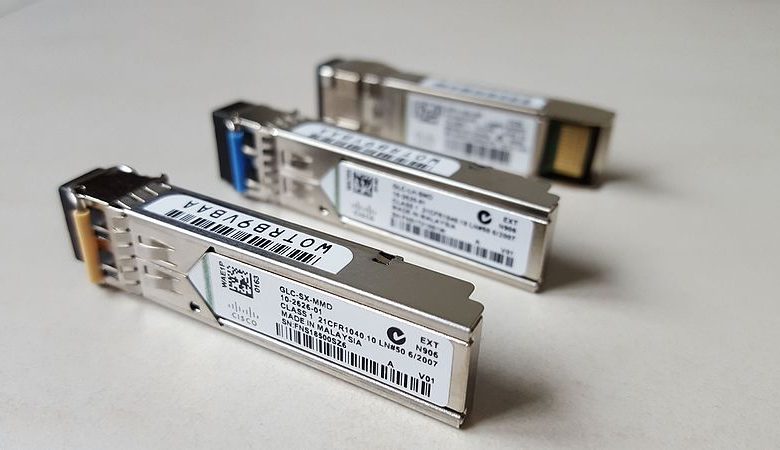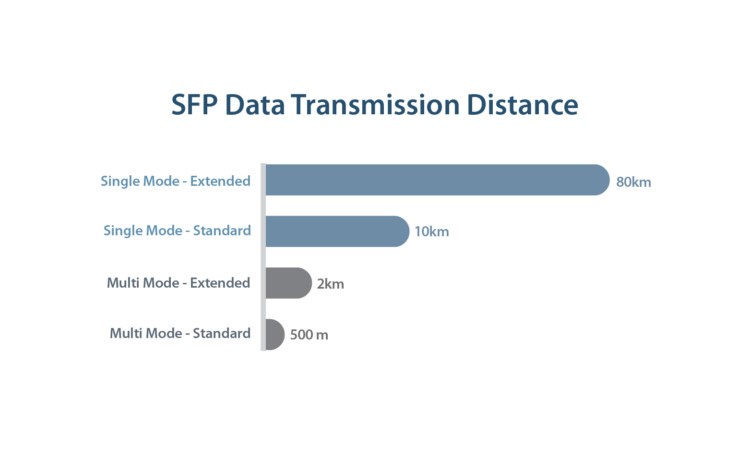The Role of SFP and SFP+ Transceivers in Your Network Infrastructure

When building out a network design, choosing the right transceivers is one of the most important but often overlooked decisions. SFP (Small Form-Factor Pluggable) and SFP+ (Enhanced Small Form-Factor Pluggable) transceivers serve as the interface between your fiber optic cables and Ethernet switches or routers, converting between optical and electrical signals. They allow you to maximize throughput, extend transmission distances, and provide redundancy — all while keeping your network flexible and future-proof.
Introduction
SFP and SFP+ transceivers are the unsung heroes that bring networks to life. From extending your reach to maximizing throughput to building in redundancy, the right transceivers can make or break your infrastructure.
The Importance of Transceivers in Network Infrastructure
Modern networks have become increasingly complex with demands for faster speeds, larger bandwidth, and lower latency. However, while advances in networking equipment, fiber optics, and protocols grab headlines, one critical component is often overlooked: the transceiver. These unassuming devices play a vital role in connecting all the moving parts of a network and enabling its capabilities.
By amplifying signals, adapting medias, and enabling new speed levels, transceivers play a pivotal and often overlooked role in building robust, scalable network infrastructures.
Understanding SFP and SFP+ Transceivers
While SFP originally stood for “small form-factor pluggable”, that name is a bit misleading nowadays. There are SFPs for long-haul telecom use cases and SFPs for short reaches of just a few meters. Maximum transmit power and sensitivity vary widely between models. Do your research to ensure an SFP will work for your specific distance and wavelength needs.
What are SFP Transceivers?
SFP transceivers, or Small Form-factor Pluggable transceivers, are versatile optical modules used in fiber optic communication networks.
SFP transceivers contain laser diodes and photodiodes packed into a compact housing no larger than a stick of gum. Within this tiny space, light is encoded with information, transmitted across fiber optic cables, decoded back into electrical signals, and delivered directly into network switches, routers, and servers. Each SFP can transfer data at rates of 1 Gigabit per second up to 400 Gigabits per second, faster than any human can comprehend.
What are SFP+ Transceivers?
SFP+ transceivers are some of the coolest technology behind modern data centers and cloud infrastructure. They allow high-speed networking over tremendous distances using fiber optics.
Fiber optics have some key advantages over copper cables for high-speed networking. Fiber optic cables are lighter, more flexible, and immune to electromagnetic interference. They can also support faster speeds and longer transmission lengths.

The Difference Between SFP and SFP+ Transceivers
SFP stands for Small Form-factor Pluggable and was introduced in 2000 as the successor to GBIC modules. SFP transceivers support shorter wavelength laser beams and can transmit data at up to 1 gigabit per second. They’re a compact, hot-swappable option ideal for environments with tight space constraints like cable management trays. However, their limited bandwidth and small optical connectors have made them legacy in most modern networks.
SFP+ or SFP double plus transceivers launched around 2006 to provide higher performance and support faster Ethernet speeds. SFP+ modules can achieve 10 gigabit Ethernet speeds and beyond using larger LC connectors capable of handling more optical power. The “plus” in SFP+ simply indicates greater capabilities and bandwidth compared to traditional SFP transceivers. Many SFP+ transceivers also support longer transmission distances of up to 120km using various wavelength ranges like 1310nm or 1550nm.
Key Features of SFP and SFP+ Transceivers
While SFP and SFP+ are quite common, there are a few unique features that make these optical transceivers stand out.
- Variable bitrate support
- Plug and play with hot swapping
- Rugged and reliable
- Flexibility and choice
Form Factor and Compatibility
SFP and SFP+ transceivers are small, hot-swappable modules that plug into dedicated cages on network switches, routers, and other equipment. Their compact size and lightweight design make them portable and easy to replace without disrupting network operations. An SFP transceiver is roughly the size of a stick of gum while an SFP+ is slightly larger, the size of a smartphone. Despite their miniature stature, they are capable of transferring data at gigabit speeds and beyond.
SFP and SFP+ transceivers are designed to provide plug-and-play compatibility across different network devices, media types, and fiber optic cables. As long as the connectors and form factor match, an SFP transceiver will work in any standard SFP cage and an SFP+ in any SFP+ cage. This open standard approach reduces compatibility issues and ensures maximum interoperability across networking ecosystems. With so many options from major brands, you can choose transceivers that suit your exact needs.

Data Rates and Distances
SFP and SFP+ transceivers provide flexible connectivity for optical fiber networks. SFP+ transceivers can support data rates up to 16Gbps, compared to 1-10Gbps for standard SFP transceivers. This allows for significantly increased bandwidth and throughput on your network. Some SFP+ options even reach 32Gbps or faster for ultra-high performance networks.
In addition to faster speeds, SFP+ transceivers also support longer link distances. You can achieve up to 120km (75 miles) of reach using specialized SFP+ transceivers, compared to only 10-100km for standard SFPs. This means SFP+ is ideal for connecting locations that are farther apart or in remote areas.
SFP and SFP+ transceivers come in a variety of wavelength options, allowing you to choose the best wavelength for your application and environment. Common choices include 1310nm, 1490nm, 1550nm, and 1625nm. Wavelength impacts both speed and distance, so choosing the right wavelength envelope for your link is key.

Fiber Types: Single-Mode and Multi-Mode
The type of fiber an SFP or SFP+ transceiver uses depends on the intended bandwidth and distance. Single-mode fiber employs a laser beam of light and can support extremely high bandwidths over extremely long distances. It is ideal for long-haul, undersea cables or data center interconnects. Multi-mode fiber utilizes a broader light beam and lower bandwidths over shorter distances, perfect for shorter links within a data center or campus network.
Common Applications of SFP and SFP+ Transceivers
While these modular optics are typically thought of solely as fiber channel or Ethernet interconnects, they have so much more potential:
- Fiber channel storage array links
- Hyperscale cloud computing campus networks
- ZWD: Zero Wait DSL
- Automotive manufacturing automation
Gigabit Ethernet Networking
SFP+ transceivers can operate at speeds up to 10 gigabits per second, enabling you to connect devices to 10 gigabit Ethernet switch ports. Some newer SFP+ modules even offer breakouts that convert a single 10GbE port into four individual 2.5GbE ports, providing more network connectivity options.
On the high-performance computing side, SFP+ and QSFPP (QSFP+) transceivers are essential for enabling InfiniBand networking at 40, 50 and 100 gigabits per second. InfiniBand is a high-speed, low-latency interconnect that is crucial for carrying data between servers, storage systems, and supercomputers.
Fiber Channel Storage Networking
While SFP and SFP+ transceivers are simple in design, they enable a variety of vital yet often unseen functions in fiber channel storage networks.
SFP and SFP+ transceivers are found behind nearly every disk drive in a storage array. Another key role of SFP and SFP+ transceivers is bridging longer distances between storage arrays or connecting arrays housed in separate data centers.
High-Speed Data Center Connectivity
High-speed datacenter networking continues to push the limits of bandwidth and latency to enable new levels of connectivity and cloud computing capabilities. SFP and SFP+ transceivers have been instrumental in facilitating these rapid advancements through their compact form factor, power efficiency, and high bitrate support. While 10G SFP+ is now ubiquitous in data centers, newer options like 25G SFP28 and 50G QSFP28 are opening up even faster lanes of communication.

Choosing the Right Transceiver for Your Network
There are more options for network transceivers than ever before, so picking the right one for your setup can be tricky. While cost and specs are certainly factors, the transceiver you choose will have a big impact on your network’s performance, reliability, and user experience.
Assessing Your Network Requirements
While most network administrators understandingly default to name-brand, mainstream transceivers, those common choices aren’t always the best for every unique network environment. Your network has distinctive needs and requirements, so it pays to evaluate the options thoroughly.
- Consider your network topology
- Evaluate your bandwidth needs
- Consider specialized transceivers
- Choose transceivers you can trust
Compatibility Considerations
Some transceivers may work wonderfully for high-speed industrial connections but disastrously for home Wi-Fi. Other factors like power requirements, antenna types, and modulation schemes also sneakily impact your decision in unexpected ways.
Let’s explore a few of the compatibility corners you’ll want to check:
- Modulation and coding schemes
- Antenna options
- Power and frequency
- Interface and form factor
Vendor-Specific vs. Third-Party Transceivers
Do you stick with the ones offered by your switch or access point vendor, or explore options from third-party suppliers? There are good arguments on both sides, so you need to evaluate based on your unique needs.
Vendor-specific transceivers, like the ones Cisco, Juniper, Aruba and others bundle with their equipment, are often the path of least resistance. They’re designed to integrate seamlessly with the platform, making setup and configuration simpler. However, they typically lack flexibility and come at a premium price. If your network requirements are straightforward, vendor gear can be a good plug-and-play choice.
For more complex networks or tight budgets, third-party transceivers shine. Companies like Finisar, Axiom and Mellanox produce a wide range of high-performance, interoperable transceivers at very competitive prices. You’ll have many more options to choose from, including different cable types, power levels and form factors. However, integration may require extra effort to ensure compatibility and quality of service.
Conclusion
Take some time to evaluate your network’s needs and choose high-quality SFP/SFP+ transceivers that will strengthen its backbone for years to come. With the right transceivers on board, you’ll have a robust infrastructure to support all your data and devices efficiently.
These little plug-in modules transmit data between network switches, cables, and other equipment. While they’re tiny, choosing the right transceivers for your setup can make a big difference.
Explore our website Network Hardwares for best price.




